Numerical Simulation of Leakage and Diffusion Process of LNG Storage Tanks
Abstract
1. Introduction
2. Materials and Methods
2.1. Numerical Model
2.2. Parameter Setting
2.3. Model Validation
3. Results and Discussions
3.1. The Influence of Wind Field on Leakage and Diffusion of LNG Storage Tank
3.1.1. Numerical Simulation of Wind Field of LNG Storage Tank
3.1.2. Leakage and Diffusion Process of LNG Storage Tank under Wind Field
3.2. Influence of Leakage Aperture on LNG Vapor Cloud Diffusion
4. Conclusions
- (a)
- After the storage tank leaked, LNG was sprayed to the ground to form a circular liquid pool and then continuously exchanged heat with air to evaporate into low-temperature steam. The diameter of the liquid pool increased first and then remained unchanged with the leakage time, and the gas cloud diffusion state was divided into three stages due to the cylindrical turbulence of the tank. In these three stages, the LNG gas cloud experienced heavy gas accumulation, entrainment heat transfer and light gas drift, with the shape gradually developing from a complete “fan blade” to a “leaf bifurcation” of heavy methane at the front end.
- (b)
- The leakage aperture greatly affected the heat transfer between LNG and the surrounding environment. It delayed the development of the liquid pool and gas cloud to a stable state. The increase of leakage aperture quantitatively affected the distribution of vapor clouds across LNG dispersion routes. The liquid pool area was increased by 10.3 times, while the length, width, and volume of the flammable vapor cloud increased by 78.5%, 22.6%, and 249%, respectively. In addition, within the variation range of leakage aperture, there would always be a local high concentration area within 200 m downstream of the storage tank. In the field near the storage tank, the clouds settled and accumulated towards the ground in the state of gas–liquid two-phase flow, and the density of the cloud was gradually lower than the air in the far-field, manifesting as light gas diffusion. This area was characterized by high concentration and long duration of methane, which should be the focus area of alarm prediction.
Author Contributions
Funding
Institutional Review Board Statement
Informed Consent Statement
Conflicts of Interest
References
- Eser, P.; Chokani, N.; Abhari, R. Impact of Nord Stream 2 and LNG on gas trade and security of supply in the European gas network of 2030. Appl. Energy 2019, 238, 816–830. [Google Scholar] [CrossRef]
- Zerouali, B.; Hamaidi, B. Predictive analysis for risk of fire and explosion of LNG storage tanks by fuzzy Bayesian network. Life Cycle Reliab. Saf. Eng. 2020, 9, 319–328. [Google Scholar] [CrossRef]
- Zhang, M.; Song, W.; Chen, Z.; Wang, J. Risk assessment for fire and explosion accidents of steel oil tanks using improved AHP based on FTA. Process Saf. Prog. 2017, 35, 260–269. [Google Scholar] [CrossRef]
- Schmidt, M.S. Atmospheric tank failures: Mechanisms and an unexpected case study. Process Saf. Prog. 2017, 36, 353–361. [Google Scholar] [CrossRef]
- Choi, I.H.; Chang, D. Reliability and availability assessment of seabed storage tanks using fault tree analysis. Ocean Eng. 2016, 120, 1–14. [Google Scholar] [CrossRef]
- Necci, A.; Argenti, F.; Landucci, G.; Cozzani, V. Accident scenarios triggered by lightning strike on atmospheric storage tanks. Reliab. Eng. Syst. Saf. 2014, 127, 30–46. [Google Scholar] [CrossRef]
- Koopman, R.P.; Baker, J.; Cederwall, R.T.; Goldwire, H.C., Jr.; Hogan, W.J.; Kamppinen, L.M.; Kiefer, R.D.; McClure, J.W.; McRae, T.G.; Morgan, D.L. Burro Series Data Report LLNL/NWC 1980 LNG Spill Tests. UCID-19075; Lawrence Livermore National Laboratory: Livermore, CA, USA, 1982. [Google Scholar]
- Ermak, D.L.; Chapman, R.; Goldwire, H.C.; Gouveia, F.J.; Rodean, H.C. Heavy Gas Dispersion Test Summary Report. ESL-TR-88-22; Lawrence Livermore National Laboratory: Livermore, CA, USA, 1989. [Google Scholar]
- Brown, T.C.; Cederwall, R.T.; Chan, S.T.; Ermak, D.L.; Koopman, R.P.; Lamson, K.C.; McClure, J.W.; Morris, L.K. Falcon Series Data Report: 1987 LNG Vapor Barrier Verification Field; Gas Research Institute Report: Chicago, IL, USA, 1990. [Google Scholar]
- Siuta, D.; Markowski, A.S.; Mannan, M.S. Uncertainty techniques in liquefied natural gas (LNG) dispersion calculations. J. Loss Prev. Process. Ind. 2013, 26, 418–426. [Google Scholar] [CrossRef]
- Chan, S.T. Numerical simulations of LNG vapor dispersion from a fenced storage area. J. Hazard. Mater. 1992, 30, 195–224. [Google Scholar] [CrossRef]
- Chan, S.T. Three-Dimensional Model for Simulating Atmospheric Dispersion of Heavy-Gases over Complex Terrain. UCRL-JC-127475; Lawrence Livermore National Laboratory: Livermore, CA, USA, 1997.
- Giannissi, S.G.; Venetsanos, A.G.; Markatos, N.; Bartzis, J.G. Numerical simulation of LNG dispersion under two-phase release conditions. J. Loss Prev. Process Ind. 2013, 26, 245–254. [Google Scholar] [CrossRef]
- VílchezJuan, A.; Villafane, D.; Casal, J. A dispersion safety factor for LNG vapor clouds. J. Hazard. Mater. 2013, 246–247, 181–188. [Google Scholar] [CrossRef] [PubMed]
- Li, J.; Ma, G.; Abdel-Jawad, M.; Huang, Z. Gas dispersion risk analysis of safety gap effect on the innovating FLNG vessel with a cylindrical platform. J. Loss Prev. Process Ind. 2016, 40, 304–316. [Google Scholar] [CrossRef]
- Zhang, Q.X.; Liang, D. Numerical simulations of LNG vapor dispersion from LNG jetting in different directions. Procedia Eng. 2016, 135, 316–321. [Google Scholar] [CrossRef][Green Version]
- Marsegan, C.; Busini, V.; Rota, R. Influence of active mitigation barriers on LNG dispersion. J. Loss Prev. Process Ind. 2016, 44, 380–389. [Google Scholar] [CrossRef]
- Nguyen, L.D.; Kim, M.; Choi, B. An experimental investigation of the evaporation of cryogenic-liquid-pool spreading on concrete ground. Appl. Therm. Eng. 2017, 123, 196–204. [Google Scholar] [CrossRef]
- Gopalaswami, N.; Kakosimos, K.; Zhang, B.; Liu, Z.; Mentzer, R.; Mannan, M.S. Experimental and numerical study of liquefied natural gas (LNG) pool spreading and vaporization on water. J. Hazard. Mater. 2017, 334, 244–255. [Google Scholar] [CrossRef] [PubMed]
- Ikealumba, W.C.; Wu, H. Effect of atmospheric and sea stability on liquefied natural gas (LNG) dispersion: Implications to Australian LNG marine transport. Fuel 2017, 197, 8–19. [Google Scholar] [CrossRef]
- Luo, T.P.; Yu, C.C.; Liu, R.M.; Li, M. Numerical simulation of LNG release and dispersion using a multiphase CFD model. J. Loss Prev. Process Ind. 2018, 56, 316–327. [Google Scholar] [CrossRef]
- Dasgotra, A.; Varun Teja, G.V.V.; Sharma, A.; Mishra, K.B. CFD modeling of large-scale flammable cloud dispersion using FLACS. J. Loss Prev. Process Ind. 2018, 56, 531–536. [Google Scholar] [CrossRef]
- Giannissi, S.G.; Venetsanos, A.G. A comparative CFD assessment study of cryogenic hydrogen and LNG dispersion. Int. J. Hydrogen Energy 2018, 44, 9018–9030. [Google Scholar] [CrossRef]
- Urióstegui-Hernández, A.; Garnica-González, P.; Ramos-Banderas, J.N.; Hernández-Bocanegra, C.A.; Solorio-Díaz, G. Multiphasic Study of Fluid-Dynamics and the Thermal Behavior of a Steel Ladle during Bottom Gas Injection Using the Eulerian Model. Metals 2021, 11, 1082. [Google Scholar] [CrossRef]
- Gallot-Lavallée, S.; Jones, W.P.; Marquis, A.J. Large Eddy Simulation of an Ethanol Spray Flame with Secondary Droplet Breakup. Flow Turbul. Combust. 2021, 107, 709–743. [Google Scholar] [CrossRef]
- Tauseef, S.M.; Rashtchian, D.; Abbasi, S.A. CFD-based simulation of dense gas dispersion in presence of obstacles. J. Loss Prev. Process Ind. 2011, 24, 371–376. [Google Scholar] [CrossRef]
- Kovalets, I.V.; Maderich, V.S. Numerical Simulation of Interaction of the Heavy Gas Cloud with the Atmospheric Surface Layer. Environ. Fluid Mech. 2006, 6, 313–340. [Google Scholar] [CrossRef]
- Sklavounos, S.; Rigas, F. Simulation of coyote series trials-Part I: CFD estimation of non-isothermal LNG releases and comparison with box-model predictions. Chem. Eng. Sci. 2006, 61, 1434–1443. [Google Scholar] [CrossRef]
- Duijm, N.J.; Carissimo, B.; Mercer, A. Development and test of an evaluation protocol for heavy gas dispersion models. J. Hazard. Mater. 1997, 56, 273–285. [Google Scholar] [CrossRef]

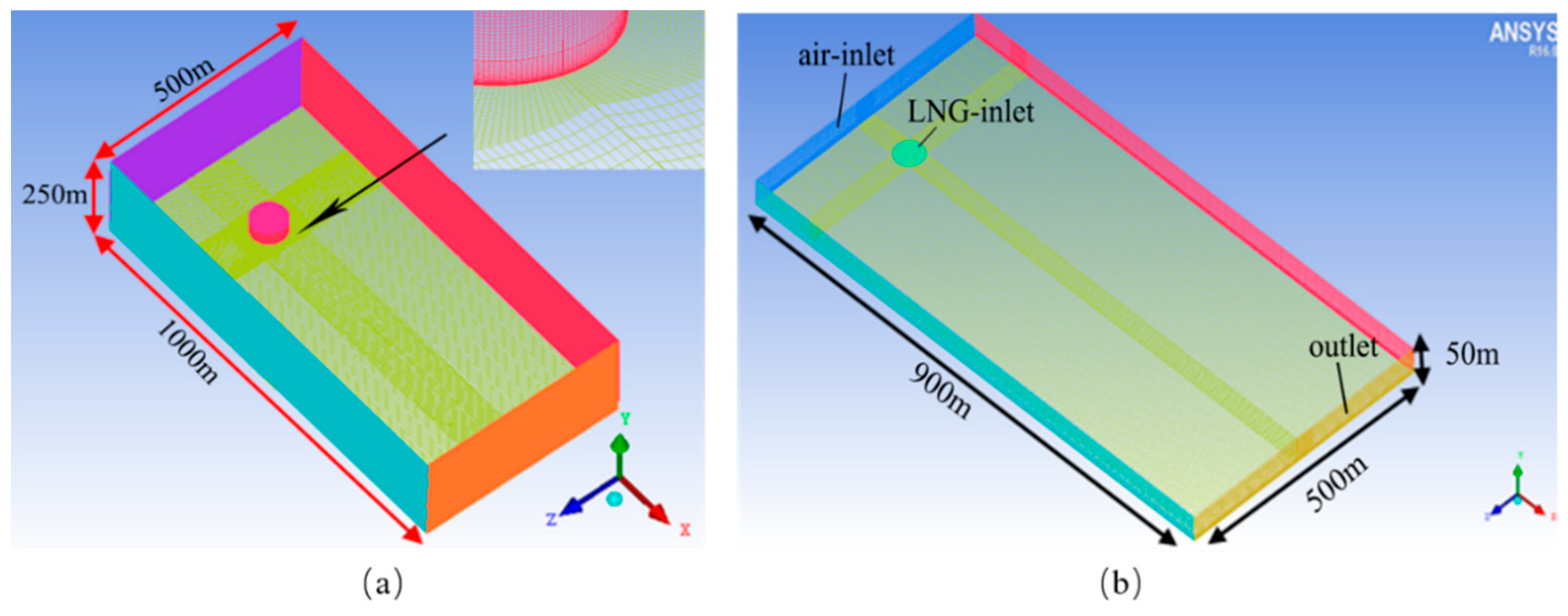



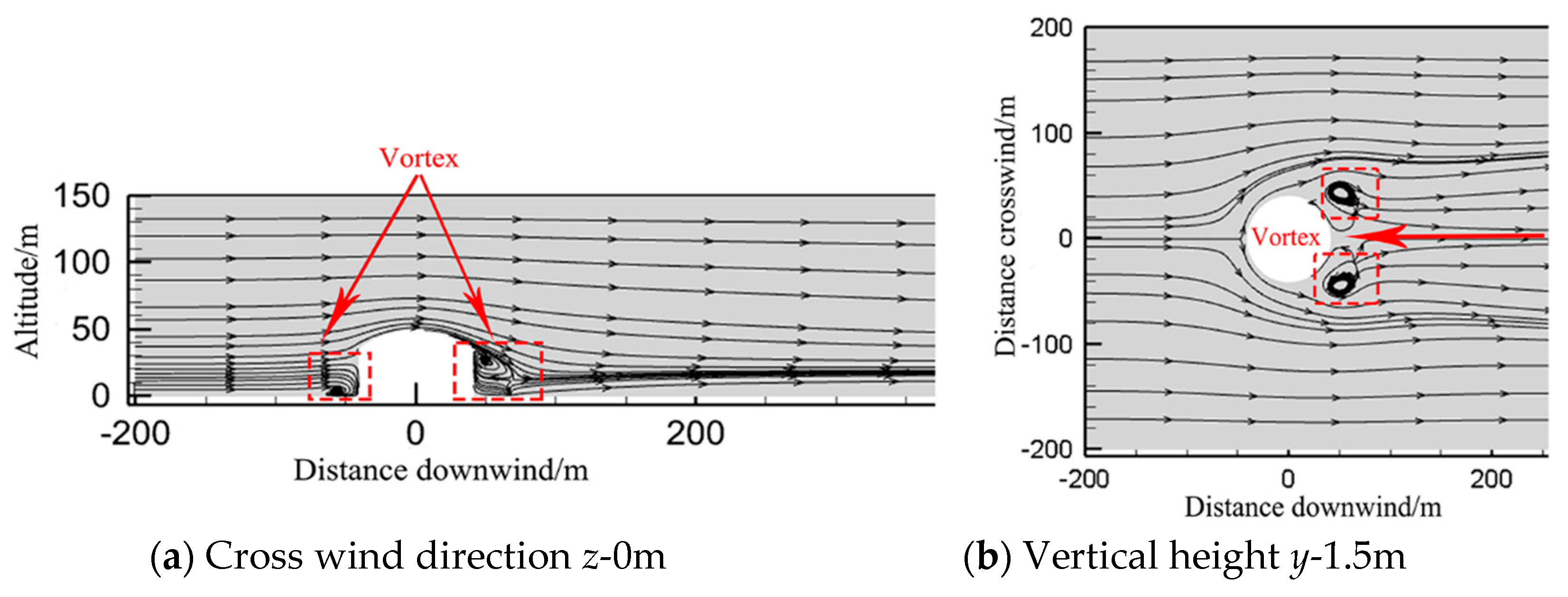
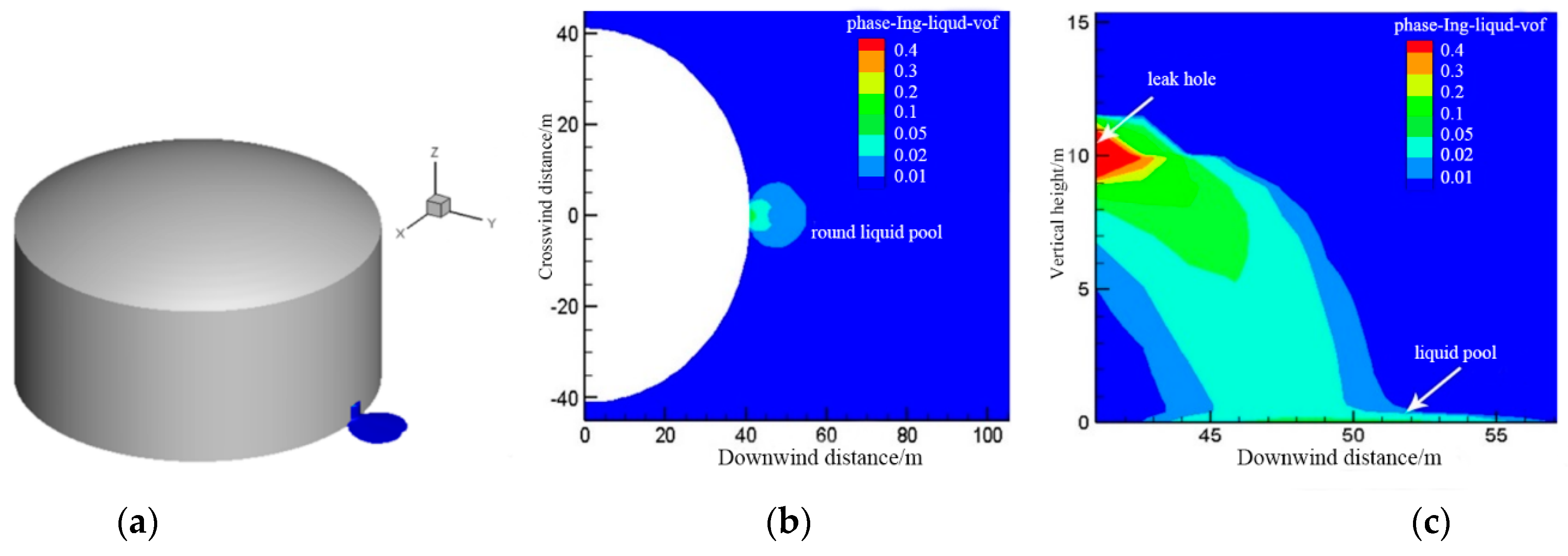
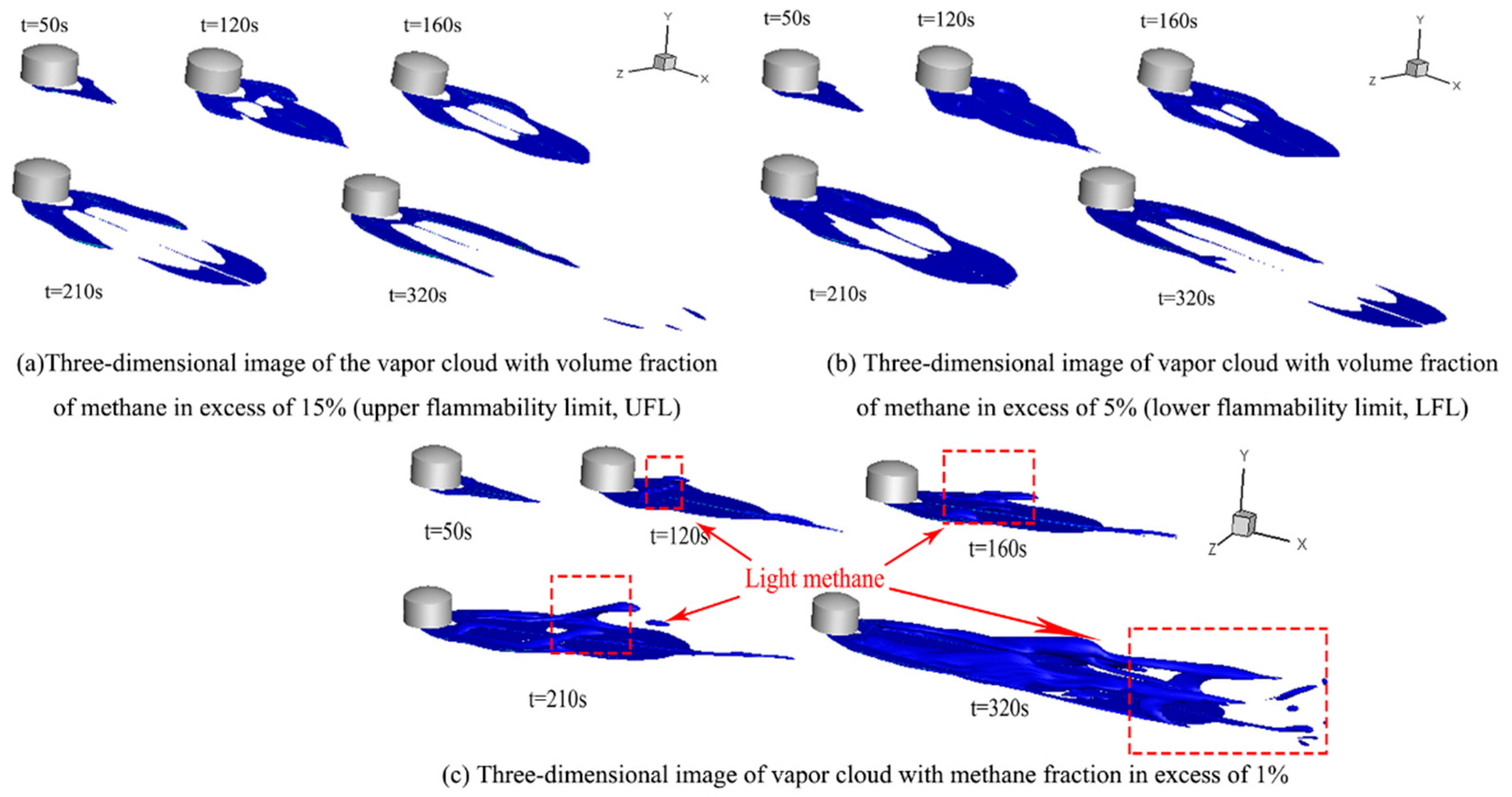
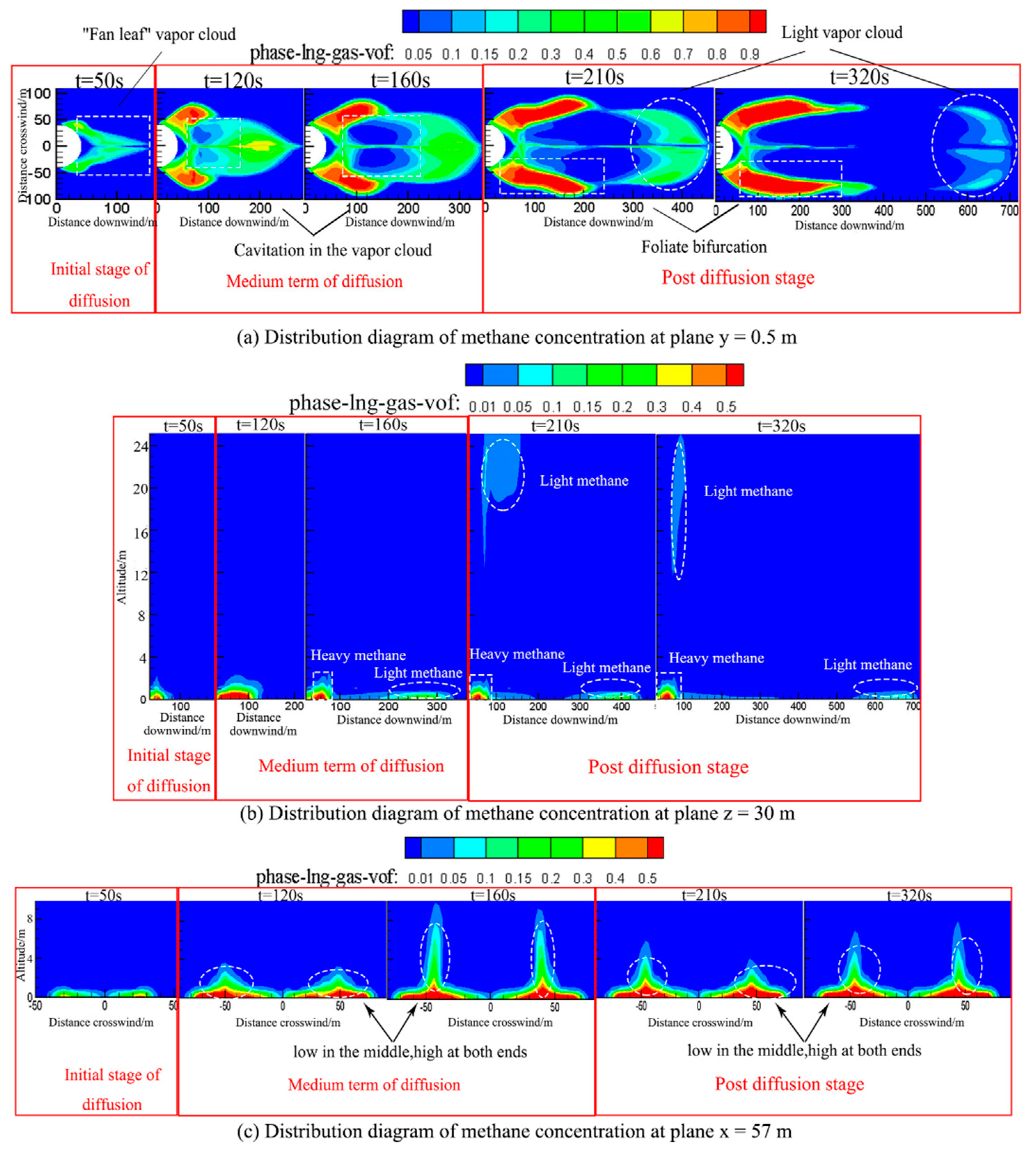


| Downwind Distance/m | Maximum Methane Volume Fraction at 1 m Height/% | |
|---|---|---|
| Test Measured Value | Fluent Simulation Value | |
| 140 | 16.49 | 15.4 |
| 400 | 4.25 | 5.32 |
| 800 | 1.93 | 2.25 |
| Deviation Statistics | FB | MG | VG | MRSE | FAC2 | NMSE |
|---|---|---|---|---|---|---|
| Ideal value | 0 | 1 | 1 | 0 | 1 | 0 |
| Evaluation standard | (−0.4, 0.4) | (0.67 1.50) | <3.3 | <2.3 | >0.5 | <4 |
| Burro 8 | −0.18 | 0.88 | 1.03 | 0.04 | 0.87 | 0.23 |
Publisher’s Note: MDPI stays neutral with regard to jurisdictional claims in published maps and institutional affiliations. |
© 2021 by the authors. Licensee MDPI, Basel, Switzerland. This article is an open access article distributed under the terms and conditions of the Creative Commons Attribution (CC BY) license (https://creativecommons.org/licenses/by/4.0/).
Share and Cite
Li, X.; Zhou, N.; Chen, B.; Zhang, Q.; Rasouli, V.; Liu, X.; Huang, W.; Kong, L. Numerical Simulation of Leakage and Diffusion Process of LNG Storage Tanks. Energies 2021, 14, 6282. https://doi.org/10.3390/en14196282
Li X, Zhou N, Chen B, Zhang Q, Rasouli V, Liu X, Huang W, Kong L. Numerical Simulation of Leakage and Diffusion Process of LNG Storage Tanks. Energies. 2021; 14(19):6282. https://doi.org/10.3390/en14196282
Chicago/Turabian StyleLi, Xue, Ning Zhou, Bing Chen, Qian Zhang, Vamegh Rasouli, Xuanya Liu, Weiqiu Huang, and Lingchen Kong. 2021. "Numerical Simulation of Leakage and Diffusion Process of LNG Storage Tanks" Energies 14, no. 19: 6282. https://doi.org/10.3390/en14196282
APA StyleLi, X., Zhou, N., Chen, B., Zhang, Q., Rasouli, V., Liu, X., Huang, W., & Kong, L. (2021). Numerical Simulation of Leakage and Diffusion Process of LNG Storage Tanks. Energies, 14(19), 6282. https://doi.org/10.3390/en14196282






